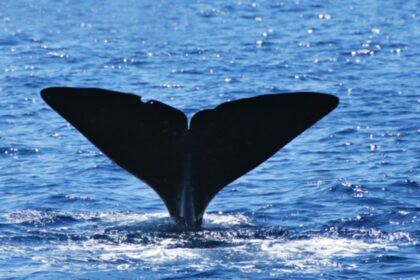
As an English composition instructor, I decided that a useful way to get my students thinking about research was to show them a documentary, what I equate to a visual form of the typical college research paper: an extended argument that relies on evidence from external sources to support its claims. I chose Gabriela Cowperthwaite’s Blackfish (2013) for a few reasons: its content, its impact, and the compelling reactions it elicited from SeaWorld as the theme park attempted to revamp its public image.
We only viewed the first 30 minutes of the film, but my students were aghast. And why wouldn’t they be? How many of us have fallen prey to the colorful, wondrous allure of the marketing behind aquariums, dolphinaria and sanctuaries that contain captive whales, dolphins and other forms of marine life?
Growing up in such close proximity to Florida, common family vacation photos that pop up on my Facebook feed include people smiling with dolphins in tourist “dolphin coves,” people in wet suits next to manatees, people holding fish over dolphin pools to get the animals to rise out the water for the perfect shot. My parents also have plenty of snapshots of my brothers and I posing in front of one the many Shamu statues to be found in SeaWorld Orlando.
But perhaps now more than ever, and especially in light of Blackfish, the ethical questions that surround captive marine life, particularly cetaceans, weigh heavily on the public consciousness.
For the responsible traveler interested in encountering marine life, how can one do so, and do so responsibly? Read on to find out.
What distinguishes a responsible dolphinaria from one that’s irresponsible?
According to Clare Hancock of Immersion Travel Magazine, the first thing to do is not judge a place by what it calls itself.
“There are many responsible zoological and aquatic organizations out there that use popular terms to bring in patrons,” she explains. “Approach them with an open mind and a list of questions. When it comes to dolphinarium alternatives, look for research and conservation organizations that take travelers to a natural setting to witness animals in the wild. These organizations won’t chuck food into the water to attract wildlife; they will travel to a place where wildlife is often seen, and they will wait for wild residents to come to them.”

Further, what distinguishes a responsible from an irresponsible organization are its end goals: education, rehabilitation, research and conservation — not profit.
What responsibility does the traveler have when visiting cetaceans in captivity?
Sarah Bareham of Responsible Travel believes that responsible travelers have three main responsibilities: to research, to report and to share.
Many resources are available for travelers to consult to make sure that the organization they plan to visit is ethical, including Responsible Travel’s “Swimming with Whales and Dolphins,” “Whale Watching,” and “Dolphin Watching” travel guides.
Ultimately, Bareham argues, “Travelers have a responsibility to research a captive facility prior to visiting – avoiding dolphinaria, as well as any ‘sanctuaries’ or zoos which encourage unnatural behavior or human interaction. By visiting these places tourists are actively supporting and encouraging the abuse and exploitation of animals.”
If one does bear witness to such abuse and exploitation, Adam M. Roberts, founder and CEO of Born Free USA and the Born Free Foundation, encourages reporting these organizations to ones like his, as Born Free “works to investigate and expose malpractice in exploitative animal entertainment and advocate for change at all levels of government in the regulations governing the keeping of animals in captivity.”
Says Roberts, “We educate travelers and all members of the public as to the cruelty inherent in captive animal exhibits and work with them to expose the worst offenders.”
Finally, travelers should feel encouraged to share their travel experiences. “Travelers can spread the word, share their experiences and encourage their family and friends to see animals responsibly on holiday, even if this is as simple as showing how seeing animals in the wild, in their natural habitat, offers a much more moving, awe-inspiring experience than captive encounters,” Bareham suggests.

What are some responsible wildlife alternatives to dolphinaria?
“Clearly the best option is viewing animals in the wild where they belong – and building travel plans around such opportunities, whether in a neighboring state or foreign country. There are some wildlife sanctuaries that are open to the public and enable people to see wild animals in humane living conditions,” Roberts says.
Indeed, responsible alternatives do exist and are worthy of responsible patronage. Hancock recommends the New England Aquarium in Boston, the Ocean Institute at Dana Point, California, and the Newport Back Bay Conservancy. Responsible Travel’s guides cite exciting locations like the Azores and Tonga for swimming with dolphins.
Bareham makes the poignant observation that witnessing cetaceans in their natural environment provides an experience that cannot be replicated in a captive-animal site:
“Seeing animals in their natural habitats! There are whale-watching trips which celebrate the unique and awesome power of these creatures on their own terms, even trips which give you the opportunity to swim with dolphins in the wild – a much more responsible, and moving experience than swimming with captive dolphins.”
For more information, visit World Cetacean Alliance, Responsible Travel, Born Free USA, and Immersion Travel Magazine.
Recommended Reads:
Wildlife Management and Conservation: Contemporary Principles and Practices by Paul R. Krausman
How to Speak Dolphin by Ginny Rorby
Citizens of the Sea: Wondrous Creatures From the Census of Marine Life by Nancy Knowlton
Have you ever had a responsible or irresponsible dolphin swimming or wildlife experience? Please share in the comments below.
Also Check Out:
How Give Back Yoga Is Providing Health To Communities In Need & The World
How Small Actions When Traveling Have A Big Impact On Children
Latest posts by Paige Sullivan (see all)
- Holiday Treats & Christmas Traditions Around The World - Dec 19, 2016
- Handouts In Developed Nations: Advice For The Responsible Traveler - Jun 7, 2016
- 5 Immersive Culinary Enclaves To Savor In NYC - Feb 18, 2016
- Traveling Responsibly & Protecting Fragile Environments - Jan 9, 2016
- Can Tiger Tourism Be Responsible? - Jan 9, 2016






I was happy to read this article and see that you brought up some excellent points about researching cetacean facilities before visiting them. However, I was disappointed to see that you recommend swimming with them in the wild. That is still not a viable solution because it has negative affects on the dolphins and the behavior that results.